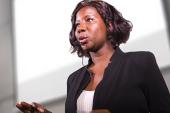Just One in Five Grand Rounds Lectures Given by Women
The proportion of female speakers increased over time, but they remain underrepresented in procedural and other specialties.

Women are vastly underrepresented as speakers at grand rounds across the United States, delivering just one in five such lectures, new research shows.
Over a 25-year period, the proportion of female speakers increased by approximately 1% per year, with the representation growing the most for topics related to women’s cardiovascular health but not changing for grand rounds with a focus on electrophysiology (EP) and basic/translational science.
“We found that women made up about 20% of the grand rounds lecturers, which is fairly equivalent to the proportion of women in cardiology,” lead investigator Ersilia DeFilippis, MD (NewYork-Presbyterian/Columbia University Irving Medical Center, New York, NY), told TCTMD. “However, when we look at the talks these women were giving, they were more frequently talking about women’s health topics, heart failure, and general cardiology. I think the fact that they were still relatively underrepresented as speakers in some of the procedural specialties shows there are areas for improvement.”
Nosheen Reza, MD (Perelman School of Medicine at the University of Pennsylvania, Philadelphia), the study’s senior author, said the unequal representation between sexes wasn’t surprising, but she was gladdened to see things were improving.
“It was great to see that even though the marginal change is small—on average 1% per year—at least we are making forward progress,” she told TCTMD. “For so long, across many metrics, things were stagnant in terms of number of women enrolling in medical school, proceeding to residency, proceeding to training in cardiology. Even if it is small, the percentage [of women given grand rounds talks] is increasing over time. These are good signs.”
A grand rounds lecture in the traditional academic model is seen as a marker of expertise and career success, said Reza, but the talks also provide opportunities for further growth and development through clinical and research collaborations. They can also lead to opportunities to mentor younger cardiologists early in their career.
“From my personal experience, I can tell you the impact that it’s had downstream on trainees to see women . . . role models that may not exist at their own institution,” she said.
Cardiology’s Gender Gap
While more women apply to and graduate from medical school—54.6% of medical school students in 2023/2024 were women, according to the Association of American Medical Colleges—the gender gap in cardiology is well documented. The percentage of cardiology faculty at US medical schools is roughly 21%, but the percentage of practicing US cardiologists who are women ranges from 12% to 14%. That percentage is even lower in certain specialties, such as interventional cardiology and EP.
A similar trend is seen in studies looking into gender gaps across leadership positions. Study after study has shown women are less likely to appear as first and senior authors, to be made full professors, and to be assigned leadership positions for cardiovascular clinical trials. One recent analysis found that women made up only 10% of cardiovascular leadership committees of studies published in several high-impact journals.
The new study, which was published online December 23, 2024, in JAMA Cardiology, focused on grand rounds from 626 academic centers with internal medicine residency training programs between 1997 and 2022. In total, 3,806 lectures from 42 centers were included in the analysis. Of the talks, 799 (21%) were given by women and 3,007 (79%) by men. Female lecturers were more likely to be assistant or associate professors, while men were more like to have full professor status.
During the study period, women gave 23.5% of the grand rounds focused on general cardiology, 14.6% of lectures on interventional cardiology, 12.8% on electrophysiology, 18.4% on multimodality imaging, 17.0% on heart failure, 15.0% on vascular medicine, 15.1% on valvular medicine, 17.7% on basic/translational research, 15.1% on cardiac critical care, and 19.5% on quality-improvement/innovation initiatives.
Proportions of women-led talks were higher for medical education (27.1%), adult congenital heart disease (55.6%), cardio-oncology (43.8%), and women’s cardiovascular health (82.5%).
Over time, the proportion of female speakers giving general cardiology grand rounds increased by 2% each year, as did the proportion of female speakers for imaging, congenital heart disease, heart failure, and cardio-oncology lectures.
For talks on medical education and quality improvement/innovation, the percentage of female lecturers increased 3% each year, while there was a 6% annual increase in female speakers on women’s cardiovascular health. Grand rounds on interventional/valvular/vascular cardiology topics given by women increased 1% year over year, with no change in EP and basic science.
Importance of Diverse Speakers
“I think visibility goes a long way in academic cardiology,” said DeFilippis. “A lot of us, whether you’re a woman or man, you spend time at your desk, oftentimes in our little silos, doing your work and taking care of patients, but it’s the people you see along the way who can really make a big difference. Seeing people who look like you on the main stage can be very inspiring.”
The 25-year study period included the COVID-19 pandemic, a time when many hospitals resorted to virtual lectures for grand rounds, she noted. This format, said DeFilippis, may help facilitate diversity of speakers by allowing women who might not be able to travel due to caregiver responsibilities at home to speak.
Seeing people who look like you on the main stage can be very inspiring. Ersilia DeFilippis
In terms of increasing the proportion of women delivering grand rounds lectures, DeFilippis encouraged those in charge of selection to be mindful of including a diverse range of voices.
“I’ve often felt as an early-career professional that cardiology grand rounds are only for the most accomplished professors who are late in their career,” she said. “Maybe it’s time to shift that paradigm a little bit.” Increasing the proportion of women, as well as mixing in younger doctors from diverse backgrounds, “can open our eyes and bring us new perspectives about illness and disease and health,” added DeFilippis.
Reza, who founded and directs the Penn Women in Cardiology program, said that when she served on the grand rounds committee, a look back through the years showed that women made up just 10% of speakers. With that knowledge, the committee made a concerted effort to diversify the list of nominations submitted to the chair and chief of cardiology.
“Within really a short period of time, just a couple of years, more than half of our grand rounds speakers were women for a couple consecutive years pre-COVID and during COVID,” said Reza. “It really didn’t take that much effort. It boiled down to somebody realizing the disparity and taking the time to search and nominate outstanding, well-deserving women who should be giving grand rounds but perhaps had just never been nominated or sponsored or saw that sort of opportunity.”
Michael O’Riordan is the Managing Editor for TCTMD. He completed his undergraduate degrees at Queen’s University in Kingston, ON, and…
Read Full BioSources
DeFilippis EM, Muppala S, Kaur G, et al. Representation of women among cardiology grand rounds speakers in the United States. JAMA Cardiol. 2024;Epub ahead of print.
Disclosures
- DeFilippis reports receiving personal fees from AstraZeneca and serving on a clinical trial committee for Abiomed.
- Reza reports speaking honoraria from Zoll, advising fees from American Regent and Bristol Myers Squibb, and research grants to their institution from Bristol Myers Squibb outside the submitted work.





Comments